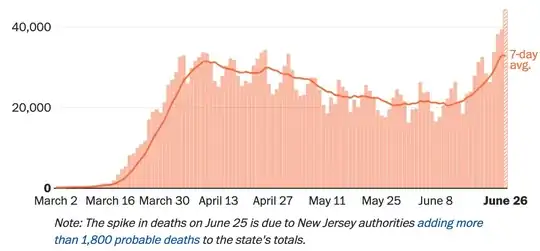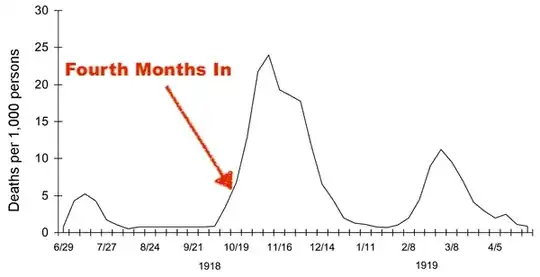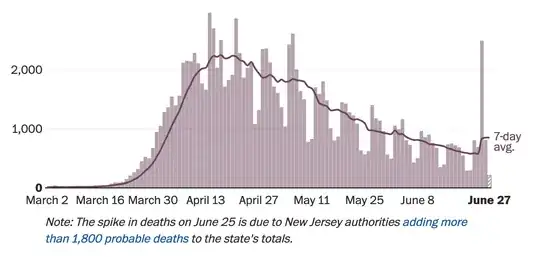Maybe, but this article doesn't show that. It is deeply flawed. It is a reiteration of the "sacrifice the elderly" argument with more statistics.
The article uses the incorrect points of comparison in various ways, it presents a rosy picture of their proposal that was known to and is being demonstrated to be false, it fails to demonstrate their plan is better than any of a number of alternatives, and as a public policy proposal it fails to examine its moral and ethical ramifications.
The US Did Not Lockdown At All Costs
The article opens with their view of the situation in the US.
Our governmental COVID-19 mitigation policy of broad societal lockdown focuses on containing the spread of the disease at all costs, instead of “flattening the curve” and preventing hospital overcrowding. Although well-intentioned, the lockdown was imposed without consideration of its consequences beyond those directly from the pandemic.
The piecemeal US federal, state, and local government response certainly did not try to contain the spread of disease "at all costs". Particularly the lackluster, contradictory, and often harmful federal response. As well as some state governments which were in denial and are now seeing spikes.
Governments who did take COVID seriously did focus on flattening the curve and preventing or reducing hospital overcrowding. And they did take into account its consequences as evidenced by economic boosts to unemployment insurance, suspending evictions, "small" business loans and grants, and so on.
Because of the piecemeal response the US did neither "lockdown at all costs" nor "flattening the curve". What we're seeing is the result of a mish-mash of everything from full denial to full lockdown with changing and confusing recommendations and mandates. While other countries similar to the US have COVID in steady decline, the US is on a sharp rise again. If we look at its success in similar countries, the "broad societal lockdown [focused] on containing the spread of the disease at all costs" they claim they're comparing against looks very different from what the US has done.
They're not comparing their reopening plan against a "broad societal lockdown", they're comparing against a broad societal screw up.
Their Plan Is Already Backfiring, and the US Knew It Would
To end the loss of life from the economic lockdown, businesses as well as K-12 schools, public transportation, parks and beaches should smartly reopen with enhanced hygiene and science-based protection warnings for any in the high-risk population. For most of the country, that reopening should occur now, without any unnecessary fear-based restrictions, many of which repeat the error of disregarding the evidence. By following a thoughtful analysis that finally recognizes all available actions and their consequences, we can save millions of years of American life.
The article was written May 25th, 2020 when US COVID cases were at their lowest since its peak in early April. Many places did as they suggested. Now our case load is spiking again.
 Source: Washington Post
Source: Washington Post
Clearly it is not working. And it's what Homeland Security predicted in March 31st.
Steady State assumes school closures until summer, 25% of people telework, and there is some social distancing
The Steady State + 30 Day shelter-inplace scenario has a greater rebound peak after the mitigation is relaxed (assuming further shelter-in-place policies are not implemented to reduce futurepeaks) than steady state
We can also look at Sweden. Sweden never locked down, how are they doing? Their death toll is at 500 per million, one of the highest in the world. Their case load continues to rise.
Comparing Apples To Apple Trees
The past century has witnessed three pandemics with at least 100,000 U.S. fatalities: The "Spanish Flu," 1918-1919, with between 20 million and 50 million fatalities worldwide, including 675,000 in the U.S.; the "Asian Flu," 1957-1958, with about 1.1 million deaths worldwide, 116,000 of those in the U.S.; and the "Hong Kong Flu," 1968-1972, with about 1 million people worldwide, including 100,000 in the U.S. So far, the current pandemic has produced almost 100,000 U.S. deaths, but the reaction of a near-complete economic shutdown is unprecedented.
Here they're comparing the complete toll of historical pandemics with the toll so far in the first few months with the existing measures and advances in medicine. The COVID death toll is likely understated. It is not an apples-to-apples comparison.
For example, the Spanish Flu lasted two years and had three major peaks. One early. A much greater one after four months. And a middle one after eight months.
The US is only about four months into the COVID pandemic. They've had their first spike, and before the first wave even finished the second one is starting. What did the Spanish Flu look like four months in?
 Source: Wikipedia
Source: Wikipedia
And let's look at the US case load four months in again.

However, deaths have not spiked (the June 25th spike is a statistical glitch). But deaths lag cases; it may still be too early to see their effect.

After four months we're seeing a second spike. If the US follows the pattern of the Spanish Flu, and I hope they do not, this is only the beginning. Thus one cannot simply project the current state of affairs on May 25th forward when comparing with historical pandemics.
The Counter-Factual Fallacy
Jack Aidely summed this up very well.
What they have done is like trying to assess the effectiveness of car safety belts and counting only the lives lost by people despite wearing safety belts and not considering the number of lives saved by wearing seatbelts. It's a total nonsense.
The danger of "what if" scenarios is two fold.
- Making your change while assuming everything else remains the same.
- Giving your scenario every break.
To the second, as we are seeing, what looked like a rosy reopening scenario in late-May has turned into messy spike in cases.
The authors compare the actual (and likely underestimated) effects of COVID with their estimated effects of a lockdown. The authors are trained in their fields, but biases towards their preferred scenario will appear.
To the first, they're comparing the (probably underestimated) deaths under piecemeal lockdown to the potential deaths due to economic inactivity. But if the US did not lock down, their cases and deaths would have been different; given the current spike they likely would have been even higher.
To have anything like an honest answer, they must compare the current scenario with a no-lockdown scenario. Homeland Security predicted at the end of March 300,000 deaths in an "umitigated" scenario, and 200,000 deaths if we reopen too early. I wonder what their models tell them now.
The article cites things like "lives also are lost due to delayed or foregone health care imposed by the shutdown and the fear it creates among patients", but an even greater pandemic would have produced an even greater delays and fear.
There is the assumption that if there was no lockdown, everyone would have proceeded as normal. Again, we know that not to be true. Already people are reluctant to risk their lives, or the lives of those around them, to go back to work, or to get a haircut, or go to a restaurant. In an even worse pandemic caused by staying open, the economy would still be impacted.
Finally, there is the emotional toll. The article's "years of life" is really cover for "sacrifice the elderly" and the immunocompromised. I have family and friends who are immunocompromised. Were I to get infected, they might get infected and could die. The thought that my family or friends died because I wanted a hamburger is horrifying.
The Demographics of COVID Patients Is Changing
The article assumes COVID will continue to target mostly the elderly once the economy reopens. But this may not hold true, and there are already signs it is shifting as states reopen.
Houston Methodist Hospital in Texas is seeing a shift towards younger patients. Their president and CEO Dr. Marc Boom says
"What it tells me is that the older, more vulnerable population is staying home and staying safe and the people younger who said, 'Hey, you know what, this is behind us, this is a lot of hype,' they let their guard down, they went out doing life as usual, and we're paying the price for that," Boom said.
Texas Gov. Greg Abbott commented when putting lockdown restrictions back into place that they're seeing more young people testing positive.
"The majority of people who tested positive since the beginning of June have been people under the age of 30," Abbott said at a press conference last week, adding that some of the increase was a result of "bar-type settings."
Source: NPR
If as the US reopens COVID begins targeting younger people, their whole argument collapses.
The Chosen Metric Devalues the Elderly
The article cannot be taken as a naive actuarial exercise, nor can we answer the simple text of the question and then stop. This is not an actuarial paper publishing their results in an academic journal. It is a public policy recommendation by public policy professionals with real consequences for real people. We must examine their chosen metric and its consequences.
In making their "the cure is worse than the disease" argument, they choose not "deaths" but "years of life" as their metric. Since a high proportion of COVID deaths are among elderly people, this allows them to paint a rosier picture of their deaths. They have devalued the lives of the elderly; you're worth less if you're older. And they've done it on a simple linear scale.
While it is valid to take such actuarial values into consideration, they should be one of many in a policy argument. Instead, the article focuses solely on years of life. Reducing one's value down to a single data point is fraught with ethical problems which the authors do not examine. Nor do they disclaim the article as an actuarial exercise not to be taken as a policy position. A position which rests upon the idea that one person's life is more valuable than another's must be thoroughly examined.
The Trolley Problem
The authors are proposing a solution to The Trolley Problem.
The Trolley Problem is an ethical thought experiment. The classic formulation is you're at the controls of a trolley speeding towards a crowd. You can change tracks to kill one person instead. What do you do?
It has infinite variations, as The Good Place illustrated in grisly detail. The answer seems obvious, you minimize casualties. What if we reformulate it? Now you're a doctor choosing between saving their patient, or letting them die and using their organs to save many others. Now what do you do?
Medical professionals have their own very real Trolley Problem when they are required to perform triage. They do this only when the need is acute and immediate. Their decision making process is backed up by a large body of ethical considerations and guidelines. To avoid conflicts of interest and biases, their metrics are about the immediate medical situation: the severity of the condition and the likelihood of recovery.
The ethical danger of the author's solution is they are triaging based on their perceived value to society, and they're doing it to an entire population. They are the doctor who will let their patient die without their consent so they can harvest their organs to save someone of a group they consider more worthy.
You Can Sacrifice Any Group With The Right Metric
By choosing the right metric, one can justify sacrificing any group they wish. If one chooses a person's contribution to the GDP, they could justify sacrificing the unemployed and disabled. If one values certain industries more than others, they can justify sacrificing the workers of the "lesser" occupations. Senator Tom Cotton recently argued that someone in Wyoming who does "mining, logging and construction, and... manufacturing" has more right to representation than someone in DC who are "bureaucrats and other white collar professionals".
False Dichotomy
Which brings us to the real problem with the "lockdown is more harmful than COVID" issue. The article presents it as if we have only two choices: your money or someone else's life.
The article cites things like "every $10 million to $24 million lost in U.S. incomes results in one additional death" and "lives also are lost due to delayed or foregone health care imposed by the shutdown and the fear it creates among patients". I don't doubt these claims. What I do doubt is that there was no way we could have mitigated them.
Why is the US doing so much worse than comparable countries? How did those countries do so well? What could the US have done better? What can they still do?
Why is the health and welfare of the US population so tied to their jobs? How does that compare to similar countries? What could the US have done to mitigate that before a pandemic hit? When the risks became clear back in February? What can they do now that we're in the middle of it?
Why was there so much fear to seek health care? The chaotic and contradictory response probably had a lot to do with that. The nature of US health care and health insurance is another. What could we have done to ensure that people did seek health care?
The public health solution to the COVID trolley problem is to slow the speeding trolley down: don't overload the medical system in the first place. These are measures to flatten the curve: husband medical resources where possible without impacting critical care; expand access to medical care; expand production of vital medical resources; and get as many healthy people to wear masks and take as many protective measures as possible.
That last one includes enacting public policy which ensures people do not have to choose between staying safe and paying the bills. Examples include: expanded unemployment insurance, moratoriums on evictions, expanded ability to conduct business at a safe distance, expanded health insurance not tied to your job, and so on.
The article fails to consider this as a third option, or any other options. Considering its grisly calculus, it is imperative to do so.
"Reopen and sacrifice the elderly" is not the only solution.


